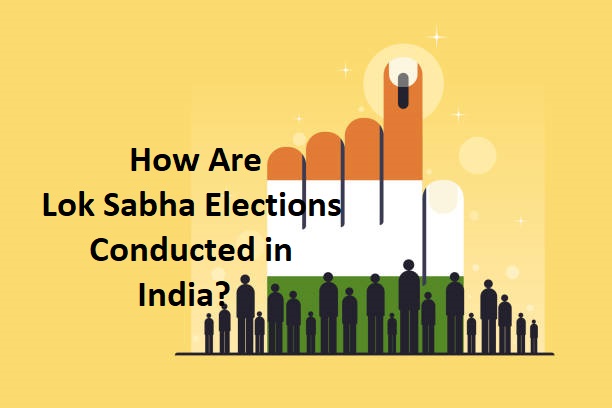How Are Lok Sabha Elections Conducted in India?
As a student, you must be curious to know How Lok Sabha Elections are conducted in India. As you know India is the world’s largest democracy. There are over 900 million eligible voters participating in the Lok Sabha elections every five years. The process of conducting these elections is a fascinating and intricate one, involving millions of polling stations, election officials, and security personnel.
In this blog article, we will look into the various steps involved in conducting Lok Sabha elections in India. Here, you will understand from the nomination of candidates to the counting of votes. We will also explore the complexities and challenges faced by the Election Commission in ensuring a free and fair electoral process. Let’s unravel the Lok Sabha Elections process step by step.
How Are Lok Sabha Elections Conducted in India?
Role of Election Commission before Lok Sabha Elections
The very first step is to announce the dates of elections in the country.
Once the dates are announced, the election commission is responsible for conducting the elections in the country.
Therefore, let us first understand the role of the Election Commission before the Lok Sabha Elections.
Ensuring Free and Fair Elections:
The Election Commission plays a crucial role.
Moreover, it has to ensure that the Lok Sabha elections are conducted in a free and fair manner.
This involves monitoring campaign activities, preventing electoral malpractices, and addressing any complaints or issues that may arise during the election process.
It is the responsibility of the Election Commission to uphold the principles of Democracy through free and fair elections.
Voter Registration and Voter Education:
The Election Commission has to ensure that all eligible voters are registered.
They have access to accurate information about the voting process.
This includes conducting voter awareness campaigns.
Also, educating voters about their rights and responsibilities, and motivating voters to reach the polling booth.
Monitoring Election Expenses:
The Election Commission closely monitors the expenses incurred by political parties.
Candidates are also monitored during the election campaign.
This is done to ensure compliance with the legal limits set for election spending.
However, the purpose is to prevent unfair advantages and ensure a level playing field for all candidates.
Conducting Polling:
The Election Commission is responsible for organizing and conducting the polling process.
It includes setting up polling booths, deploying election officials, and overseeing the voting process to ensure a smooth and transparent election day.
Moreover, they also implement security measures to maintain law and order during the elections.
Implementing Code of Conduct:
The Election Commission also enforces a Model Code of Conduct during the election period.
This is done to ensure that political parties and candidates conduct themselves respectfully and ethically.
Moreover, this includes guidelines on public behavior, campaign activities, and the use of media to maintain a fair and peaceful electoral environment.
Ticket Distribution Process:
With Lok Sabha elections coming up, candidates are busy strategizing on how to secure a ticket to contest in the prestigious elections.
The process of getting a ticket is not as simple as one might think, as it involves a lot of factors and negotiations.
One common way for candidates to secure a ticket is through their political party.
Party loyalty, seniority, past performance, and network all play a crucial role in determining who gets the ticket.
Candidates who have strong backing from party leaders and have a good rapport with the party workers are more likely to be chosen as the official candidate.
Another way for candidates to get a ticket is through their popularity and influence in their constituency.
Finally, candidates who have a strong public image, a good track record, and a loyal voter base are considered strong contenders for the ticket.
Filing Nomination:
As the Lok Sabha elections approach, candidates from various political parties gear up to file their nomination papers.
in order to contest for a seat in the coveted lower house of the Indian Parliament.
However, the process of filing a nomination is not as simple as it may seem.
Candidates have to first ensure they meet all the eligibility criteria set by the Election Commission of India.
It includes being a citizen of India and not facing any disqualification under the Representation of the People Act, 1951.
They also need to have a proposer and a seconder who are registered voters in the constituency they wish to contest from.
Once all the paperwork is in order, candidates have to physically submit their nomination papers.
These papers are submitted to the Returning Officers of their respective constituencies along with a security deposit.
This deposit is forfeited if the candidate fails to secure a certain percentage of votes in the election.
The filing of nomination papers is just the first step in what promises to be a long and grueling election campaign.
Distribution Of Seats By Political Parties:
Are you curious about how seats are distributed before the Lok Sabha elections?
It’s not as simple as it may seem.
In this article, we’ll break down the process and give you a better understanding of how it all works.
The Lok Sabha, or the lower house of Parliament in India, has a total of 545 seats.
Out of these, 543 are elected by the people of India, while the remaining two are nominated by the President of India.
The seats are distributed among the various states and Union territories based on their population.
The process of seat distribution is governed by the Delimitation Commission.
They are responsible for determining the boundaries of parliamentary and assembly constituencies.
.The Commission takes into account factors such as population size, geographical location, and administrative convenience
Let’s take the example of the state of Uttar Pradesh.
It is the most populous state in India and also has the highest number of Lok Sabha seats at 80.
The distribution of seats in Uttar Pradesh is based on the population of each district within the state.
The Delimitation Commission carefully examines the demographic data and determines the number of seats each district is entitled to.
For instance, if a district in Uttar Pradesh has a large population, it may be allocated more seats compared to a district with a smaller population.
This ensures that the representation in the Lok Sabha is proportionate to the population of each region.
Once the seats have been allocated to each state and Union territory, political parties start the process of selecting candidates to contest in the elections.
Forming an Alliance With Other Parties:
In the political landscape of India, alliances play a crucial role in shaping the outcome of the Lok Sabha Elections.
But have you ever wondered how and why parties form alliances before the elections?
Parties come together to form alliances for a variety of reasons.
Firstly, the primary motive is to increase their chances of winning by pooling their resources and strengths.
By joining forces, parties can expand their reach to different regions and segments of society.
By doing this, they increase their chances of securing seats in the Lok Sabha.
Secondly, forming alliances is to counter the dominance of a powerful political party or coalition.
By banding together, smaller parties can effectively challenge the ruling party and provide a viable alternative to the voters.
An example of this is the Mahagathbandhan in Bihar.
It was formed by several regional parties to take on the Bharatiya Janata Party (BJP) in the 2019 Lok Sabha Elections.
The alliance comprised parties like Rashtriya Janata Dal (RJD), Indian National Congress, and others.
These parties joined forces to counter the BJP-led National Democratic Alliance (NDA) in the state.
Thirdly, by forming an alliance, parties can also leverage each other’s strengths and expertise in various areas.
This includes campaigning, fundraising, and mobilizing voters.
This allows them to run a more coordinated and effective election campaign.
All these factors ultimately improve their chances of winning seats in the Lok Sabha.
Publicity to win the Lok Sabha Elections
Social Media Campaigns:
In today’s digital age, social media has become a powerful tool for political parties to reach a wider audience.
Parties like the Bharatiya Janata Party (BJP) and the Indian National Congress (INC) have put significant resources into creating engaging content on
platforms like Facebook, Twitter, and Instagram to connect with voters and showcase their policies.
Traditional Media:
While social media plays a crucial role, traditional media still holds sway in Indian politics.
Parties often release advertisements in newspapers, on television, and on radio to ensure that their message is heard by a broad spectrum of voters.
These advertisements can range from personal testimonials to policy announcements.
Roadshows and Rallies:
Another common tactic used by political parties is organizing roadshows and rallies featuring prominent leaders.
These events serve as a way to energize supporters, showcase the party’s strength, and connect with voters on a personal level.
Parties often use catchy slogans and symbols to leave a lasting impression on voters.
Door-to-Door Campaigning:
Many parties also rely on the tried and tested method of door-to-door campaigning to win over voters.
Volunteers go from house to house, engaging with residents, distributing pamphlets, and discussing the party’s platform.
This grassroots approach allows parties to connect with voters on a more personal level and address their concerns directly.
Alliances and Partnerships:
In some cases, parties form alliances and partnerships with other political entities to bolster their publicity efforts.
By joining forces with like-minded parties, parties can expand their reach and present a united front to voters.
These alliances often involve sharing resources, coordinating campaigns, and pooling support to increase their chances of winning the election.
Ballet Box Distribution All Over India
With the Lok Sabha Elections approaching in India, the importance of ballet boxes reaching every corner of the country cannot be overstated.
These crucial containers are the vessels through which the voice of the people is heard.
Ensuring their timely arrival is vital for a smooth election process.
But how exactly do ballet boxes manage to reach every part of India before the elections?
The answer lies in meticulous planning and coordination.
The Election Commission of India works tirelessly to ensure that ballot boxes are distributed efficiently.
From major urban centers to remote rural villages, no area is left untouched.
Additionally, the use of technology plays a key role in this process.
GPS tracking and smart logistics systems help monitor the movement of ballet boxes and ensure they reach their destination on time.
Therefore, this level of precision is crucial for maintaining the integrity of the electoral process.
The Process of Voting:
With Lok Sabha Elections swiftly approaching, it’s imperative to understand the process of voting.
The voting process is a crucial part of democracy.
It allows citizens to elect their representatives and have a say in the decisions that impact their lives.
To participate in the Lok Sabha Elections, you must first ensure that you are registered as a voter.
The Election Commission of India manages the voter registration process and issues Voter ID cards to eligible citizens.
On the day of the elections, you must visit your designated polling booth with your Voter ID card in hand.
Once you reach the polling booth, you will need to show your Voter ID card to the polling officials.
They will mark your finger with indelible ink to prevent multiple voting.
You will then be given a ballot Box with the list of candidates and their respective symbols.
Make sure to carefully review the options before casting your vote by pressing the button next to the candidate of your choice.
Your vote is confidential and anonymous, ensuring that your decision remains private.
Once the voting period ends, the ballots are counted and the results are announced.
Moreover, by understanding the process of voting during the Lok Sabha Elections, you can exercise your right to vote.
Remember, every vote counts!
Counting of Votes:
Finally, as the Lok Sabha Elections approach, many people are curious about the process.
The counting of votes in the Lok Sabha Elections is a meticulous process that ensures the accuracy and transparency of the results.
As the polling booths close, the Electronic Voting Machines (EVMs) are sealed and transported to designated counting centers.
The EVMs are then opened in the presence of representatives of all political parties to ensure fairness.
Each vote is meticulously counted and recorded, with the results being announced once the process is complete.
During the Lok Sabha Elections, political parties play a crucial role in mobilizing voters, campaigning for their candidates, and monitoring the election process.
Political parties deploy their members to polling stations.
This is done to ensure that the voting process is conducted smoothly and fairly.
Moreover, they play a significant role in scrutinizing the counting process to ensure that the results are accurate and transparent.
Declaration of Results:
After the declaration of the Lok Sabha Election results, the real work begins.
The party with a majority in the Lok Sabha forms the government and the leader of that party becomes the Prime Minister.
They will then begin the process of forming their cabinet, selecting ministers, and outlining their policy agenda for the upcoming term.
Meanwhile, the opposition party will regroup and strategize for the next election cycle.
The newly elected MPs will also start their work in Parliament, attending sessions, debates, and working on legislation.
It’s a time of transition, as the old government steps down and the new one takes over.
The focus shifts from campaigning to governing, and the promises made during the election must now be fulfilled.
It’s a crucial time in Indian politics.
The decisions made in the aftermath of the election results will shape the direction of the country for the next five years.
Conclusion:
We hope that this article will help you in knowing the full process of Lok Sabha Elections. You know that:
the Election Commission plays a vital role in safeguarding the democratic process.
They ensure that Lok Sabha elections are conducted in a transparent, impartial, and efficient manner.
Further, securing a ticket for the Lok Sabha elections requires a combination of political acumen, public support, and party backing.
Alliances are formed before the Lok Sabha Elections to increase the chances of winning.
However, different political parties use various tactics to ensure that their message reaches the masses and resonates with voters.
The process of seat distribution before the Lok Sabha elections is a complex and crucial step in ensuring fair representation for all regions of the country.
Therefore, winning the Lok Sabha elections requires an effective publicity strategy that leverages a mix of social media, traditional media, on-the-ground campaigning, and strategic partnerships.
By utilizing these tactics, different parties strive to connect with voters, communicate their message effectively, and ultimately secure victory at the polls.





0 Comments